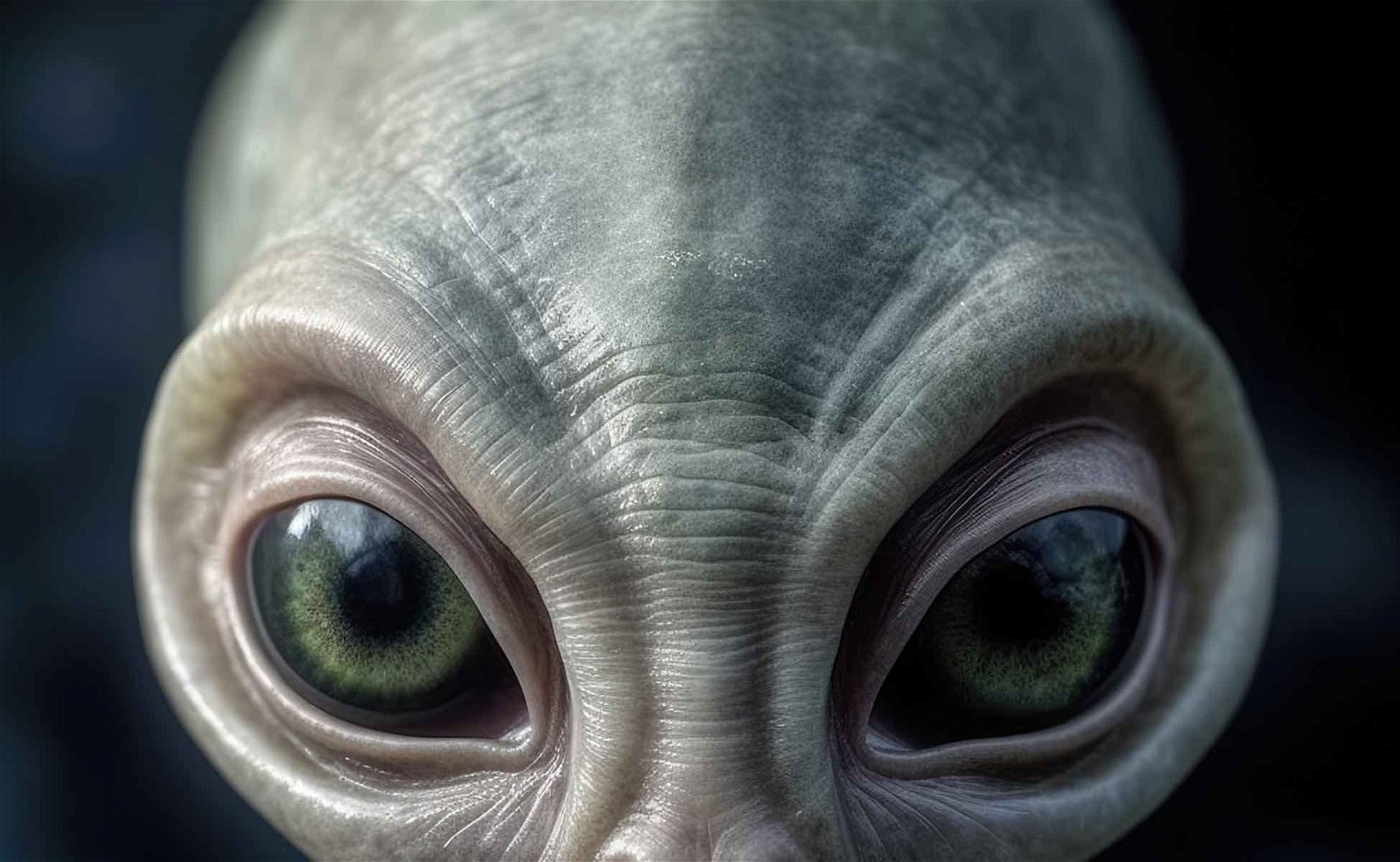In a recent interview, actor William Shatner called the July 26 House Oversight Committee hearing on unidentified aerial phenomena (UAP) or the idea that extraterrestrial intelligence was visiting Earth “ridiculous.”
During the hearing, Air Force veteran and former intelligence officer David Grusch testified regarding his claims first reported by The Debrief that he had uncovered a “multi-decade UAP crash retrieval and reverse engineering program” during his official duties. Grusch alleges personal knowledge that the U.S. government has secretly squirreled away intact and partially intact craft of “non-human origin.”
Appearing on News Nation, Shatner expressed his cynicism about the claims that the government might have crashed alien technology or that UAP incidents, as a whole, might represent some form of extraterrestrial intelligence.
“You mean, some highly intelligent being goes 10,000 light-years with advanced technology, arrives here, and hides?” Shatner said. “It doesn’t make any sense.”
After pontificating on the mysteries of the universe, including life after death, the actor famously known for portraying Star Trek’s Captain Kirk went on to promote his latest business venture, the Houston-based startup Space Crystals. For $150,000, customers can join Space Crystal’s “Immortalize Me” program and have their DNA grown into a crystal and jettisoned to the moon.
In fairness, Shatner was not attempting to present a scholarly argument on extraterrestrial intelligence, and the claims that UAP represents a visiting “non-human” species remain unproven.
Nevertheless, the question of extraterrestrial life is a captivating thought experiment for scientists and curious minds alike. As we venture deeper into the cosmos, it’s hard not to speculate what intelligent aliens might be like, should they exist.
Continued discoveries of potentially habitable exoplanets and advancements in astrobiology have provided new scientific insights, increasing the possibility that extraterrestrial life does indeed thrive throughout the universe.
And while complete certainty remains elusive, scientists have made more academically rigorous conjectures over the years about the potential physiology and behavior of intelligent extraterrestrial beings.


One of the foundational assumptions is that extraterrestrial life would be carbon-based, much like life on Earth, because carbon’s chemical properties make it uniquely suited to form the complex molecules required for life. Some astrobiologists, like Dr. William Bains of the Massachusetts Institute of Technology and Dr. Dirk Schulze-Makuch of Technical University Berlin, have also argued for the possibility of silicon-based life, given silicon’s chemical similarity to carbon.
The “Gray Alien” has become one of the most recognizable archetypes in popular science fiction and UFO lore. Typically described as humanoid and small in stature, around 3.5 to 4 feet tall, the aliens are usually depicted with smooth, gray-colored skin, large heads with almond-shaped black eyes, and elongated limbs.
While the gray alien is primarily viewed as a potent symbol in contemporary culture, scientists say it’s not entirely crazy to consider that an extraterrestrial species might have a similar, humanoid appearance.
Many prominent academics, like Cambridge University zoologist Dr. Arik Kershenbaum, believe the principle of convergent evolution applies on a cosmic scale. The principle suggests that similar environmental challenges lead to the evolution of similar physiological traits in disparate species.
“It dawned on me that the underlying principles of life apply to every aspect of animal form and function – and that’s the bottom line we can use with aliens as well,” Dr. Kershenbaum writes in The Zoologist’s Guide to the Galaxy: What Animals on Earth Reveal about Aliens – and Ourselves. “Examples on Earth can tell us a lot about what to expect on other planets because Darwin’s theory of evolution holds up throughout the Universe.”
Consequently, this means familiar structures, such as bipedal locomotion, could easily appear in an extraterrestrial species.
Ultimately, what physical features an alien species would possess would depend on the conditions of their home planet and how their bodies evolved to optimize survival. For instance, in a 2018 paper published in Astrobiology, a team of astrobiologists proposed that alien life on exoplanets orbiting M-dwarf stars may have evolved enhanced visual sensitivity to infrared light due to their stars’ low light output.
Similarly, highly-intelligent extraterrestrials may have evolved complex sensory and cognitive capabilities, with large brains requiring a disproportionate skull like the archetype gray alien.
Steven J. Dick, American astronomer, author, and former Chief Historian for NASA, has theorized that some extraterrestrial species may possess cognitive abilities far superior to humans based on having larger brain-to-body size ratios. Dick suggests these super-intelligent aliens might employ entirely different modes of thought and communication beyond human comprehension.
Dr. Kershenbaum notes that the multitude of earthly animals which have evolved different ways of transmitting information suggests that any intelligent extraterrestrial species would most likely possess a means of communication. Instead of communicating in ways beyond human comprehension, Dr. Kershenbaum says aliens might interact with each other through very familiar means.
“There aren’t really that many different ways to communicate. So by looking at the ways animals communicate on Earth, we pretty much cover the range of what’s going to be happening on other planets too,” Dr. Kershenbaum writes.
On the behavioral front, leading theorists in the hypothetical study of extraterrestrial psychology suggest that alien behaviors will be similarly influenced by the environmental conditions on their home planets.
In Astrobiology: Understanding Life in the Universe, British astrobiologist Dr. Charles S. Cockell posits that competition might drive the evolution of highly aggressive or cooperative alien species on a planet with scarce resources. Alternatively, species might develop less aggressive, more exploratory behaviors on a world with plentiful resources.
Social behavior in many Earth species stems from the necessity of survival. From wolf packs to human societies, social structures often emerge when individuals cannot meet all survival needs alone. Therefore, intelligent extraterrestrials could likely exhibit some form of social behavior.
In The Meaning of Human Existence, the late Harvard biologist and father of sociobiology, Dr. Edward O. Wilson, argues that specific environmental conditions promote the evolution of cooperative social structures, which in turn pushes the development of higher intelligence.
By analyzing the intellectual and social development of Homo Sapiens, Dr. Wilson predicted the characteristics of a hypothetical extraterrestrial intelligence on an Earth-like exoplanet. According to him, intelligent aliens would likely be land-dwellers, as he proposes that it is difficult to envision an aquatic species being able to develop past iron-age technology.
Dr. Wilson says intelligent extraterrestrials would likely evolve to be a relatively large species due to having a body proportional to having a large brain, with a body mass of around 22 – 220 lbs. They would likely be biologically audio-visual, with large distinct heads and bilaterally symmetric bodies.
He additionally theorized that intelligent aliens would likely have very high social intelligence as a necessity for functioning in fast-moving and complex social networks. He also argues that cooperation, as seen in highly social species on Earth, leads to some degree of altruism and self-sacrifice, suggesting intelligent extraterrestrials would also have some form of morality.


At the core of the UFO or UAP discussion is the belief that the sightings of mysterious, unexplained, airborne objects represent some technology of a visiting extraterrestrial intelligence. Skeptics are dubious of these claims, saying the evidence for such incredible assumptions is seriously lacking.
Nevertheless, the subject of extraterrestrial technology provides another intriguing angle when exploring the existence of intelligent alien life. How advanced might it be, and in what ways could it differ from our own?
It’s plausible that an extraterrestrial civilization could be millions of years older than humanity, with technology far beyond our comprehension. The Kardashev Scale, a classification system for civilizations developed by Russian Astrophysicist Dr. Nikolai Kardashev, provides a conceptual lens for this question.
According to Kardashev, a Type I civilization can utilize and store all the energy available on its planet. In contrast, a Type II civilization could harness the total energy output of its star, and a Type III civilization would command the energy of its entire galaxy.
In Physics of the Future, Futurist Michio Kaku suggests that humanity currently sits around Type 0.7, having yet to fully harness Earth’s energy. Given this scale, a Type II or III extraterrestrial civilization’s technology might be indistinguishable from magic to us, as Arthur C. Clarke famously posited.
For example, a sufficiently advanced alien race could construct megastructures like Dyson spheres to capture a star’s energy or use advanced propulsion systems for interstellar travel.
Extraterrestrial technology might also be radically different from human technology. Extraterrestrial intelligence could employ bioengineered tools and structures, utilizing principles of self-replication and self-repair observed in living organisms. For instance, spacecraft that heal themselves or cities that grow like organisms.
Scientists and futurists have long discussed the potential for self-replicating deep space probes that mimic features found in living organisms or viruses. These devices are often called “von Neumann probes,” named for the Hungarian-American mathematician and polymath Dr. John von Neumann, who first envisioned them.
While this sounds like science fiction, there have been several breakthroughs in material science in recent years, suggesting self-replicating technology here on Earth is very much on the horizon.
Another topic that has gained much attention in recent years is the idea of cybernetics and “transhumanism,” or the concept of enhancing the human body through technological devices or implants. Companies like Neuralink or Blackrock Neurotech are actively working to develop brain-computer interface technologies that would integrate neural implants that could repair or vastly improve cognitive and sensory-motor functions.
Many leading theorists believe advanced extraterrestrials would similarly integrate technology with their biology, perhaps even achieving digital immortality by existing as digital minds within silicon or quantum computers.
Pondering extraterrestrial technology isn’t merely an exercise in imagination but a call to broaden our own technological paradigms. Several researchers and engineers have unambiguously cited science fiction epics like Star Wars or Star Trek as inspiration to work on bleeding edge technologies, such as warp drive propulsion or tractor beams using acoustic levitation.
As we engage with the possibilities of alien technology, we may also uncover new avenues of innovation and discovery that help propel humanity further into the cosmos.


The crux of Shatner’s argument that UFOs or UAPs don’t represent an advanced alien species is based on the opinion that a visiting extraterrestrial intelligence would be evident upon their arrival. “If they were, they would make their presence known,” Shatner said during his News Nation appearance.
Unfortunately, we don’t have any other examples of aliens for comparison to help us explore Shatner’s sentiments. Nevertheless, scientists say some legitimate concerns and potential implications must be considered when considering contact with an extraterrestrial species based on historical Earthly examples.
One of the primary concerns of contact between alien races is the potential for biological contamination, often called “backward contamination.” If extraterrestrial organisms were inadvertently introduced to Earth’s biosphere, the results could be unpredictable and potentially disastrous, as Earth’s life forms would have no natural defenses against such organisms.
Many experts and space organizations have called for establishing international policies to address “harmful contamination” now before the existence of extraterrestrial life has been identified. NASA currently operates a Planetary Protection office within its Office of Safety and Mission Assurance which focuses on protecting solar system bodies from contamination by Earth life and, likewise, Earth from possible alien life forms.
The “Father of the NASA SETI program,” the late Dr. John Billingham, expressed concerns about the potential of cultural contamination involved with contact between aliens and humans. Much like early explorers on Earth who inadvertently caused devastation to indigenous cultures, Dr. Billingham argued that it’s plausible that contact with an extraterrestrial intelligence could lead to similar upheavals. Equally, humans might inadvertently harm an alien society simply through our influence, even with the best of intentions.
Perhaps the most debated issue is the fear of a hostile response from an advanced civilization.
Preeminent theoretical physicist and cosmologist Stephen Hawking famously warned that an encounter with a technologically superior civilization could bear similarities to the contact between Native Americans and Europeans, which did not fare well for the former.
Considering that the advancement of human technology has often simultaneously negatively affected Earth’s ecosystem, it is not beyond the realm of possibility that a highly advanced alien civilization might find themselves on a dying planet, starved of resources. Should the Earth provide itself as an ideal new home planet, could an extraterrestrial intelligence easily see conquering humanity as a viable means for its own survival?
Given the prevailing belief that there are an infinite number of habitable planets capable of harboring life, it is inevitable that some form of hostile aliens do indeed exist throughout the cosmos. Because of this, some scientists argue we should focus on listening for extraterrestrial signals rather than broadcasting our own.


Striking to the core of the idea that aliens capable of visiting Earth would make their presence known, some leading experts have proposed several scenarios in which extraterrestrial intelligence could be “invisible.”
A case for “invisible aliens” could be made using the concept of linguistic relativity and linguistic determinism, also popularly known as the Sapir–Whorf hypothesis. This controversial theory proposes that language structure influences a person’s cognition and perception of reality.
One of the most well-known examples of linguistic determinism is the curious fact that until relatively modern times, humanity’s diverse languages did not contain a word for the color blue. For example, in the Iliad and Odyssey, the 8th Century Greek poet Homer described the ocean as “Wine-dark” rather than blue.
Proponents of the Sapir–Whorf hypothesis suggest that humans could not perceive the color blue because they lacked the linguistics to describe it. Modern research involving the remote Namimba tribe in Southern Africa, whose language lacks a word for blue, has offered some debated evidence potentially validating this hypothesis.
If the theory of linguistic determinism holds valid, this could mean that we could not perceive extraterrestrial life with features totally alien to human understanding. Essentially, these totally abstract aliens would be invisible to us.
Additional support for the idea that we might be unable to “see” complex and obscure alien life comes from less speculative advances in neuroscience. Recent studies involving the psychedelic drug LSD have shown that human perception consists of the brain processing familiar environmental stimuli while simultaneously dismissing countless ambiguous stimuli.
Based on neuroimaging, researchers have found that LSD induces hallucinations by forcing the thalamus, a kind of neural gatekeeper in the brain’s posterior cingulate cortex, to perceive stimuli that would otherwise be excluded. In essence, the hallucinations, while under the influence of psychedelics, are the brain’s best attempt at perceiving environmental stimuli that would otherwise be ignored.
“The overwhelming evidence from neuroscience shows that humans perceive reality through neural gating, or taking in limited bits of external information to form reality, rather than absorbing all the information that’s available,” neuroscientist and theoretician at University College London and the 18th most cited scientist of all time, Dr. Karl Friston, told The Debrief. “Basically, there’s much more to reality out there than we ‘see’ or perceive.”
Based on this, it begs the question: Could alien life be an external stimulus or aspects of reality we are currently incapable of perceiving?
Another scenario for invisible extraterrestrial life involves the “Zoo Hypothesis” of the Fermi paradox. This theory speculates that advanced extraterrestrial intelligence might intentionally refrain from communication or detection to avoid interfering with Earth’s natural evolution and sociocultural development or prevent interplanetary contamination.
The “Laboratory Hypothesis” is a variant of the zoo hypothesis suggested by the former MIT Haystack Observatory scientist Dr. John Allen Ball, proposing that humanity is being subjected to experiments by an alien species that choose to remain unseen.
Ironically, given Captain Kirk’s stated opinion, the fictional federation of planets that make up the Starfleet in the Star Trek media franchise advocates the Zoo Hypothesis.
“Starfleet General Order 1,” or the “Prime Directive,” prohibits Starfleet members from interfering with the natural development of alien civilizations, including introducing advanced technology and knowledge until an extraterrestrial species is ready.
The Prime Directive has been featured as a central moral question of establishing first contact with new alien worlds, beginning with the first season of the original Star Trek series in 1966.
While the Prime Directive of Star Trek is a work of fiction, the ethics of making contact with an alien race is a legitimate consideration. What right do we have to potentially disrupt another civilization or expose them to our problems? This question has no easy answers and is one that scientists say must be contemplated seriously before any attempt at contact is made.
While these concerns are undoubtedly speculative, like much of astrobiology, they provide essential ethical and practical guidance. It also serves as a reminder that initiating first contact between alien races is far from a black-and-white issue.
In a universe as vast and intricate as ours, the mystery of extraterrestrial life has long sparked debates within scientific communities and the wider public.
From cynical opinions, like Shatner’s, to cutting-edge theories of astrobiology, the search for life beyond our pale blue dot remains one of humanity’s most profound quests. Skepticism, curiosity, and wonder intermingle as experts and laypeople grapple with the complexity of a universe that still hides its secrets from us.
Regardless of whether one is inspired by recent UAP news or the recent advances in space exploration, many believe that if extraterrestrial life does exist, we are on the precipice of making one of the most significant discoveries in human history.
Until then, as the late astrophysicist Carl Sagan once eloquently noted, “The universe is a pretty big place. If it’s just us, it seems like an awful waste of space.”
Tim McMillan is a retired law enforcement executive, investigative reporter and co-founder of The Debrief. His writing typically focuses on defense, national security, the Intelligence Community and topics related to psychology. You can follow Tim on Twitter: @LtTimMcMillan. Tim can be reached by email: tim@thedebrief.org or through encrypted email: LtTimMcMillan@protonmail.com

